Kevin's Papers
Technical Papers by Kevin Morrison
Penguin Analysis: SEO Isn’t Dead, But You Need to Act Smarter (And 5 Easy Ways to Do So!)
The new Google Penguin update was a big change that has been very unsettling to SEO’ers, both blackhats and whitehats. It seems that everywhere you go, people who had previously considered themselves to be “professionals”, are now dumbfounded as their stable authority sites have moved from ranking in the top 5 for competitive keywords, to not ranking at all.
There has never been more whispers (both jokingly and not), that SEO is dead. Which leads me to…
The Number One Question People Are Asking:
What Did This Update Do and How Do I Recover? (By Reading This Post. Duh!)
TE Jungle is in a unique position; we have historical ranking data for thousands of websites. We have data on sites that are still doing great, and we have data on sites where rankings have tanked. We’ve decided to mine through all of this data (giving us a nice large sample size), and the results we found, although not unexpected by us, should give you a clear indication as to exactly how you should build and rank sites moving forward.
Ok, Now On To What You Really Care About. What Did We Find Out?
Link over-optimization is one of the most thrown around concepts in the SEO community now, so it was naturally where we decided to look first. We took a look at the sites that tanked and the sites that didn’t, and for both we looked at what their anchor text distribution was.
More specifically, we were interested in seeing what percentage of those links had anchor text for keywords that the site was trying to optimize SERP visibility for (such as “blue widgets”) versus any other type of anchor text (this could be “bluewidgets.com”, “blue widgets | the number one widget site”, “click here”, or anything that wasn’t a keyword containing measurable search volume).
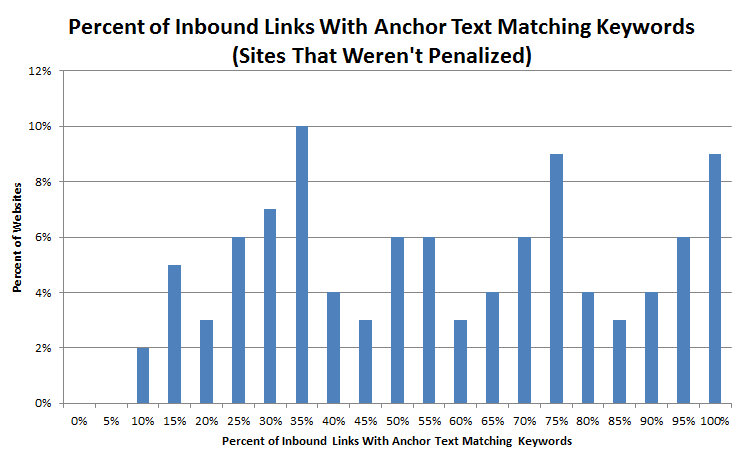
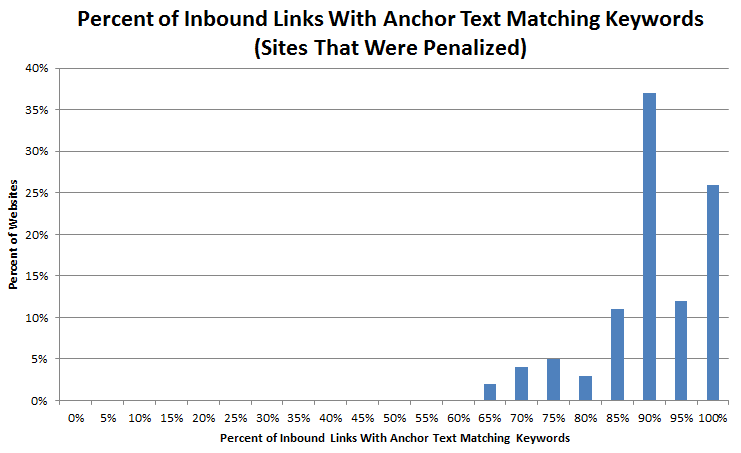
What does this mean? It means that every single site we looked at which got negatively hit by the Penguin Update had a “money keyword” as its anchor text for over 60% of its incoming links. On the other hand, the sites that were not hit by the update had much more random percentages. Having over 60% of your anchor text being a money keyword did not guarantee that your site would be hit by the penalty (many of the sites not affected had numbers just as bad), but if under 50% of your anchor text for incoming links were “money keywords” it’s all but guaranteed you weren’t affected by this update.
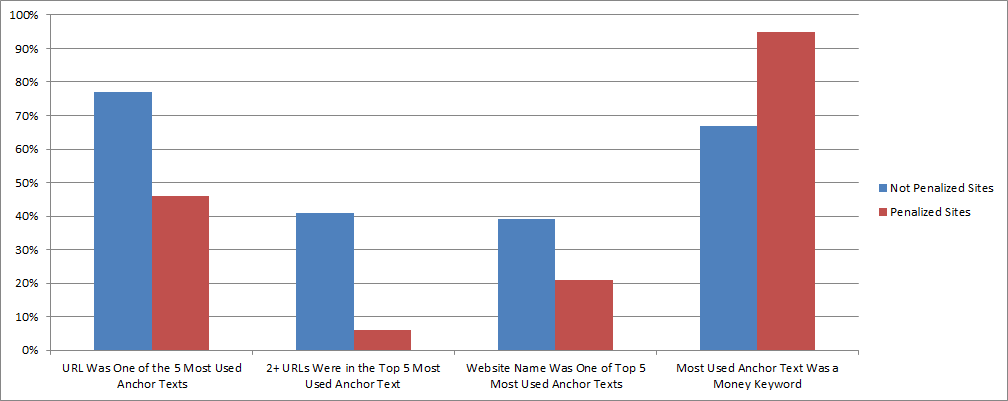
Taking a look at the above information we compiled says much of the same. The graph above shows that only 5% of the sites affected by the update had a URL structure (ex: bluewidgets.com) as 2 or more of their 5 most common anchor texts. On the other hand, nearly half of the sites not affected had the same. What does this mean? Most of you will say that this is a clear example that Google has issued a link over-optimization penalty (or at the very least over-optimization link devaluation), and that is absolutely correct.
However, that’s only half of what we uncovered (in fact, it’s the least important half!)
If This Update Isn’t Just About Over-Optimization, What Else Is Factored?
In the recent post made by Matt Cutts, he specifically called out pages that were trying to fake relevancy (or just weren’t relevant at all), and gave an exaggerated example of what to avoid.
Although his example is a little extreme, it gives insight into what Google is going after: links that are not relevant (and therefore not likely to be created naturally). This should come as no surprise to anybody that Google wants to avoid this. After all, how can a “citation” or “recommendation” (which is how the concept of link “valuation” first came to be) be valid if the citation or link has absolutely nothing to do with the page or site that it is on?
We decided to test this by taking a look at the top links for all of the sites contained in our study to see how many of those links came from sites that are in the same, similar, or related niches.
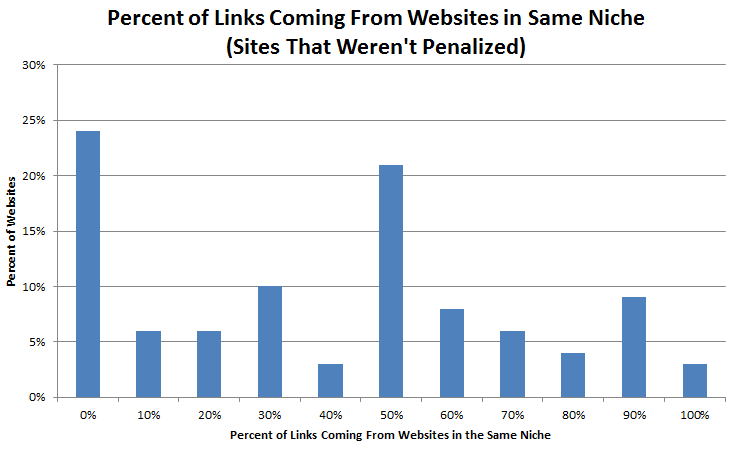

This data shows something very important: penalized sites generally had very little links coming from domains and websites in the same niche. The numbers obviously show that it’s OK, and probably beneficial to have links coming from nonrelevant sites, however it’s important to supplement those links with links coming from sites relevant to the subject matter of your site.
Conclusion: What Is Google Doing?
We just demonstrated the “actions” Google is taking by evaluating one of the best data sets in existence to conduct a case study of this nature, so it should be obvious that Google is trying to prevent over-optimization of links in terms of anchor text use and valuating links from relevant sites higher than links from non-relevant sites in terms of SERP visibility for the promoted site.
If you take a look at those two facts separately, you get two separate things you should be doing.
However, if you take a look at those two results together, a juicier piece of info comes out:
Google is trying to replace or devalue “anchor text” use with “niche/content relevancy of linking sites” as a primary link relevancy, (or “quality”) signal.
Anchor text, has been proven by SEO’ers for the past 10 years as easy to manipulate. However, obtaining links from websites or pages in a similar niches and with relevant content to the keyword you’re trying to rank for is generally much harder to manipulate. This reality and ease of the manipulation obviously prompted Google to create this update.
Furthermore, unlike 2 or 3 years ago, the technology to determine the niche of a domain or webpage is becoming much easier and much cheaper to use. That means reliance on anchor text is not nearly as big of a “ranking factor” as it was before when it was much harder to determine content relevancy on a large scale.
That’s Some Great Info! But What Exactly Should I Be Doing?
(I’m Lazy and Don’t Care About Google Updates. I Just Want to Rank!)
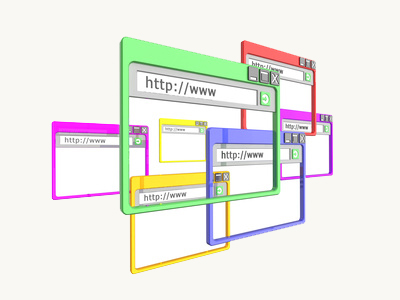
Method #1: Create Microsites
What are those? Besides being important enough to SEO that we decided to use that as one of the words in our company name, they have been a great way to rank sites in the past, and continue to be even after this update. Microsites are small(ish) topic-focused sites that provide useful content relative to your niche, and make sure to cite your main site as a primary source. Google wants the Internet to be filled with sites that provides users what they are looking for, and give authority to sites that are relevant to what the user is looking for. By creating smaller sites of “higher quality”, you get to expand your presence in your niche, and use that expanded visibility and send relevant and authoritative positive ranking signals towards your main site.

Method #2: High Quality Blog Networks
This might be the most “black hat” solution, but it’s still affective. Recently ALN and BMR have proven that low quality networks which seemed to good to be true, are too good to be true.
It’s no longer enough to have private networks with small amounts of content, anchor text that is poorly placed within the context of the article, no (or very little) accountability in the area of content quality, and other gaping network-wide footprints and general low quality attributes.
A completely internalized niche blog network (which in reality is really a group of microsites) is as effective as it ever was and generally more selective than large public blog networks to ensure proper quality control and avoid footprints. More on that later!

Method #3: Diversify Anchor Text
If you are building links yourself, you have probably reached a decision where you could spend X (whether in time or dollars) with the anchor text of “a term I want to rank for” or “a term that appears naturally but I’m not trying to rank for”. Although you are consciously aware that you need a natural mix of both, each time an SEO’er is faced with that decision they tend to usually pick the first option because, well… it’s no fun to spend time and money building links that will probably not directly help you rank! Stop doing that and make sure that over 50% of your links contain anchor text that isn’t a keyword you are trying to rank for.
What anchor text should you be using? From the data we’ve evaluated, “MySiteDomain.com”, “MySiteDomain”, “http://mysitedomain.com”, “http://www.mysitedomain.com”, “The Title of My Website”, “here”, and “the title of one of my H1′s (that isn’t a keyword I’m trying to rank for)”, were generally used as anchors on sites that were not affected by the most recent Google update and are probably a good starting point to consider using moving forward.
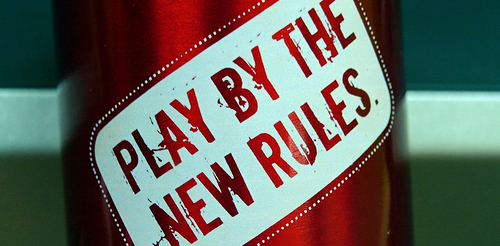
Method #4: Play Google’s Game
Get completely legitimate whitehat links! All of the previous points are ways to emulate a “natural” backlink profile. Meaning, ways to make your site look like it’s whitehat, despite possibly taking some shortcuts. The other (often forgotten) thing you can do, is actually use whitehat strategies!
Write legitimate guest posts on niche sites, find ways to get media coverage (HARO is probably one of the easiest ways to find news stories related to your niche). Last, as we’ve talked about before, viral marketing not only provides lots of visitors, but a ton of legitimate link power.

Method #5: Run Your SEO Sites Like a Real Business
One of the biggest things I noticed when pouring through our massive amounts of data is that sites that portrayed themselves as a “business” fared a lot better than sites which viewed themselves as a way to obtain and leverage traffic from Google in order to monetize.
What does this mean? A lot of things, but one of them is to look at other traffic sources besides Google. Not only will that make you less reliant on Google, and their seemingly fickle SERP shuffles, but those other traffic sources will almost certainly indirectly help your site rank better on Google.
Bonus Method: Keep Checking This Blog!
Each of the points above are worth an entire post, and over the next couple of weeks we’ll be doing exactly that. So come back often to see each of those 5 points fleshed out as its own full blog post!
I’m Too Lazy To Even Read Bullet Points. Give Me The Cliff Notes!
SEO is getting harder, but it’s still possible (and still relatively easy) to make money with it. Stop being lazy, and a good way to do that is to not rely on these cliff notes and actually read the article!
When you subscribe to the blog, we will send you an e-mail when there are new updates on the site so you wouldn't miss them.
